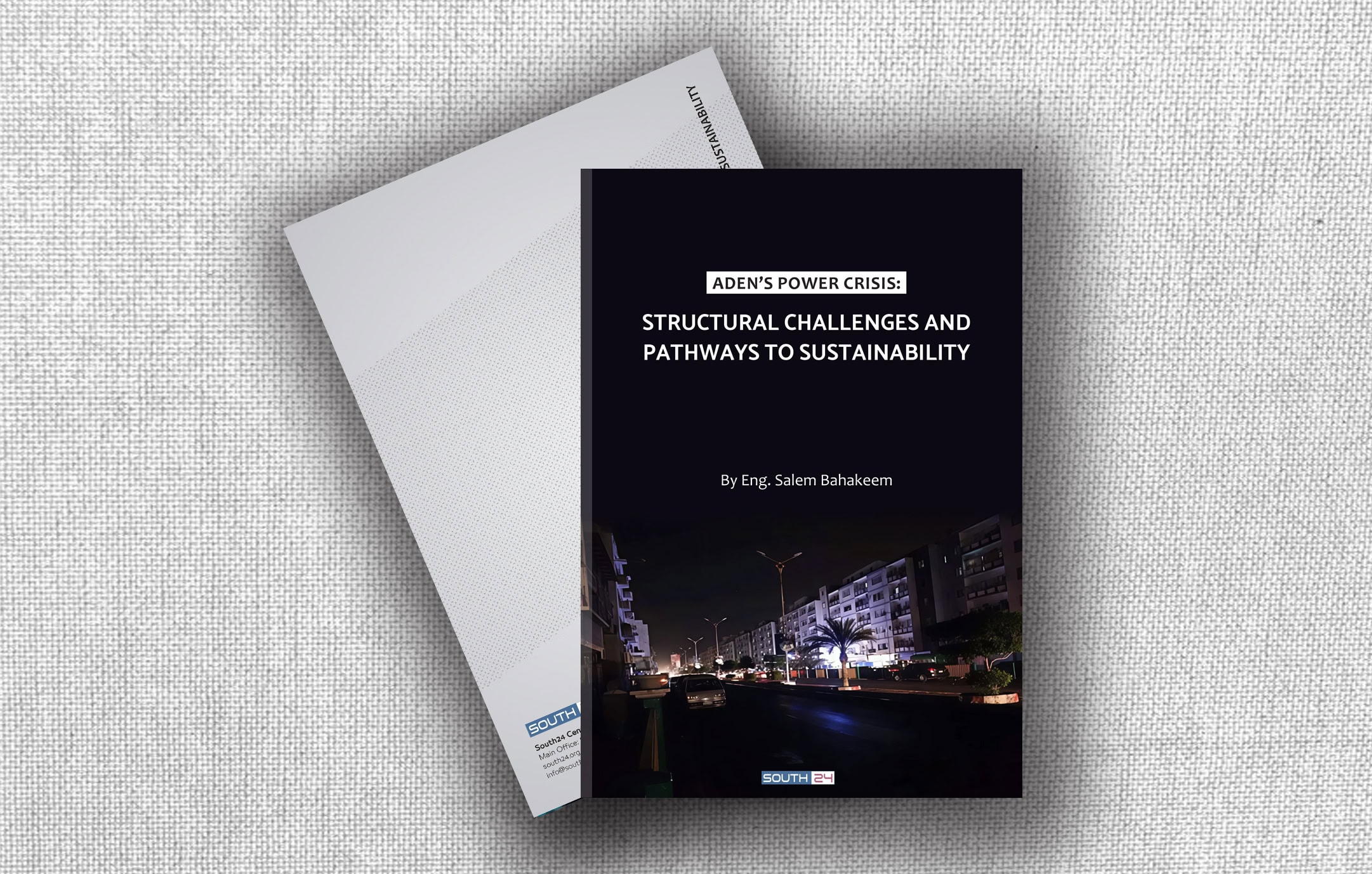
Cover of the research paper - South24 Center for News and Studies
آخر تحديث في: 14-04-2025 الساعة 9 مساءً بتوقيت عدن
|
|
This paper issued by the South24 Center for News and Studies monitors the chronic electricity crisis in the city of Aden, which has worsened over decades due to war, political, and economic crises, resulting in a 'sharp deterioration in service levels' and 'unprecedented electricity outages since its introduction to the city in 1926.' This makes the crisis a structural challenge that requires a clear roadmap for urgent and sustainable solutions that enhance generation efficiency and reduce dependence on fossil fuels
Salem Ahmed Bahakim (South24 Center)
Introduction
The electricity sector in Yemen, especially in Aden, is facing decadesـlong structural challenges, which have exacerbated due to the successive political and economic crises. Prior to the outbreak of the civil war in 2014-2015, the Aden electricity grid was linked to the unified national electricity system from which it was partially supplied with power along with local power plants. However, the war has led to Aden's exit from this system. Its power stations are no longer capable of meeting the growing power demand. These stations mainly rely on fossil fuels, especially diesel. This has made the system vulnerable to the vicissitudes of fuel prices and the supply problems.
Although the Marib gas-powered station entered service in 2010, the projects aimed to boost its generation capacity haven’t witnessed any developments to keep pace with the growing demand, especially in Aden. Moreover, the armed conflict has led to major destruction of the electricity infrastructure as well as the separation of South Yemen’s system from the national grid. This has caused a sharp decline in the level of services. In Aden, the current generation capacity doesn’t cover the increasing load. The grid suffers from structural fragility, leading to repeated power outages. In February, the city witnessed a complete power outage lasting several days due to fuel depletion. Such a situation has never been witnessed in the city since the introduction of electricity in Aden in 1926.
Until 2023, the city of Aden depended on the Mansoura and the Haswah power stations as the two main sources of energy. Besides, it relied on some small plants and purchased diesel-power stations.
The construction and operation of the President gas-powered station in Al-Haswah during 2023-24, which consists of two gas-powered units with a total capacity of 264 megawatts, has contributed relatively to the improvement in electricity supplies. In addition, the launch of a solar plant in 2024, with a capacity of 130 megawatts, has helped reduce pressure on the grid during the daytime in addition to decreasing the consumption of fossil fuel.
Despite these developments, technical, financial, and administrative challenges continue to remain as real obstacles to the stability of the electricity sector. To ensure the sustainability of the electricity system, there is need to implement a clear roadmap which includes urgent and sustainable remedies as part of a medium-term plan over five years. This plan should include comprehensive solutions to improve the generation efficiency, reduce fossil dependence, and enhance good governance in the sector in order to achieve stability of the system and tackle the exacerbating power crisis.
Analyzing the Performance of power stations in Aden. Operational Efficiency and Ongoing Challenges
The government-owned stations consist of big gas, steam, and diesel- powered plants such as Mansoura, besides small stations spread across Aden with a total available capacity estimated at 220 megawatts. Besides, there are commercial power plants with a total capacity of 100 megawatts. Additionally, there is the solar power station with an installed capacity of 120 megawatts (the actual available capacity is 90 megawatts during daylight hours).
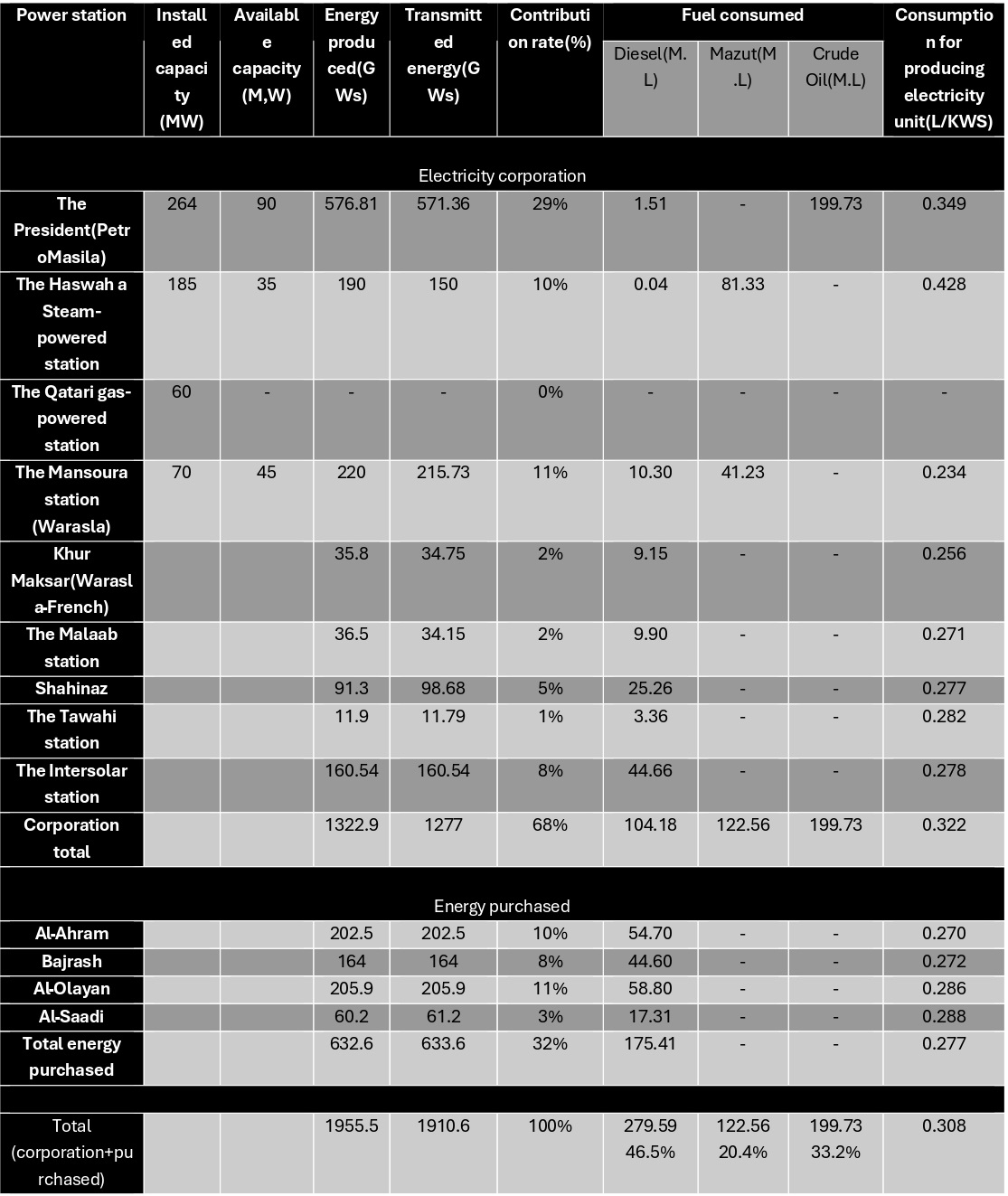
Table No. (1) shows the current production capacities of government and commercial power stations in Aden and the volume of fuel consumed during the year 2023. (South24 Center) [1]
Analyzing Technical Indicators of Power Stations in Aden during 2023
Based on the operational data for 2023, in a report issued by the Generation Department of the Aden Electricity Corporation, as shown in the above table, a number of important factors can be deduced about the performance of power stations in Aden as shown below:
1. Fuel Consumption Efficiency
The Haswah steam-powered station suffers from a significant rise in fuel consumption, as it needs 0.428 liters per kilowatt-hour produced and about half a liter per kilowatt-hour transmitted. In contrast, the other stations record more efficient rates, with an average of 0.234 liters per kilowatt-hour. Due to the obsolescence of the Haswah station and decline in its efficiency, it is recommended to phase it out of service gradually and replace it with a new highـefficiency plant.
Moreover, the efficiency of the President power station can be improved by 25% to 30% if it is switched to the ’Combined Cycle‘ system – using both a gas and a steam turbine together, according to the development plan included in the main design of the plant.
2. Major Reliance on Diesel
Diesel constitutes about 46.5% of total fuel consumption. This is considered the main factor for the soaring operational costs, along with the large losses in the grid. These financial challenges impose a heavy burden on the state along with unjustified losses estimated at millions of dollars annually.
3. Failure to Exploit the Full Generation Capacity
The President gasـpowered station is operating at less than 50% of its actual capacity due to fuel supply shortages. It currently produces about 90 megawatts although it is designed to reach 220 megawatts in case of regular fuel availability.
4. Unexploited Combined Capabilities
There is an inoperative 250 megawatts of generation capacity due to maintenance issues or the lack of fuel, as shown below:
The Chinese turbine in the Haswah station (60 megawatts): It is out of service as maintenance work was not completed.
The Qatari station (60 megawatts): It is out of service as the turbines need to be repaired. Furthermore, the President station (unexploited 130 megawatts) is operating at less than half its capacity due to fuel shortage.
Challenges Facing the Electricity Sector in Aden
1. Destruction of Infrastructure and Decline in Production Capacity
The ongoing war and the deteriorating economic conditions in Yemen have led to a partial or total destruction of power stations and the transmission lines that connect the Aden system to the unified national grid. This has led to a sharp decline in the production capacity. Although the crisis has exacerbated due to the conflict, the governmental neglect of the sector before 2015 and the lack of investments in new projects have further complicated the situation and increased the energy shortage.
2. Failure to Exploit the Combined Generation Capabilities
Despite the severe crisis in the energy sector in Aden, about 250 megawatts of the available generation capacity isn’t exploited as mentioned previously. This reflects chronic operational and administrative challenges. These unexploited capabilities include:
● The President gas-powered station: It was designed to be powered by natural gas according to its technical design. However, unavailability of gas has forced the station to rely on crude oil. Due to the non-availability of adequate and regular amounts of fuel, the production of the station has declined to less than half of its designed capacity. Since entering service, its actual capacity has not exceeded 90 of a total 220 megawatts. Sometimes, it stops working for days when it runs out of fuel.
● The Haswah gas-powered station: It consists of two gas-powered units with a total capacity of 60 megawatts and depends on diesel. It suffered a major malfunction due to which the turbines had to be taken outside the country for maintenance. They have not been fixed back so far.
● The Chinese Turbine in Haswah: It has a capacity of 60 megawatts. However, it has been out of service due to failure to complete its required maintenance.
The inability to exploit these available capacities deprives the electricity system from an important generation source that could contribute to reducing the shortage and power outages.
3. The High Rate of Electricity Loss
The distribution grid suffers from technical and administrative problems, that led to a rise in the electricity loss rate of 44% of the total energy produced in 2023, compared to only 20% prior to 2015. This loss is attributed to technical flaws in the grid and the weak inspection measures, combined with the spread of illegal consumption of electricity. The financial losses resulting from the loss exceeding the normal rate were estimated at 20%, which amounts to more than $100 million over one year, according to my personal estimates based on global oil prices.
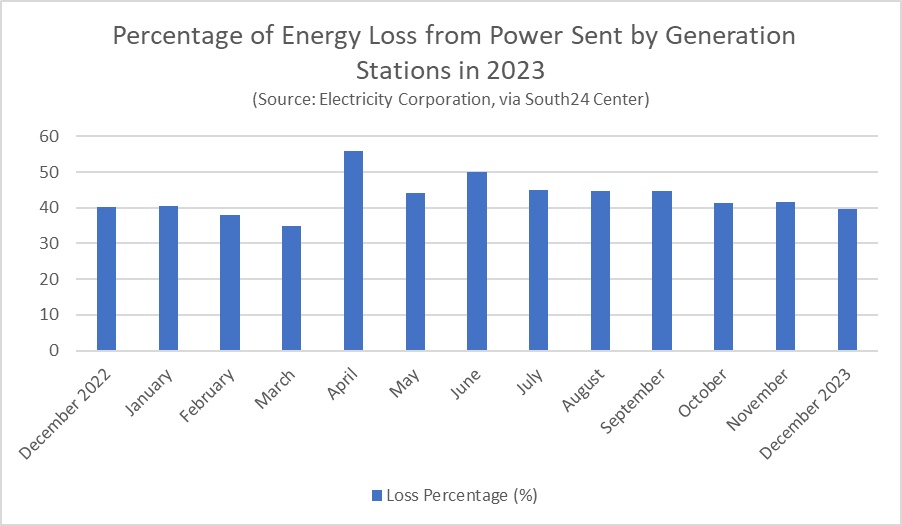
4. Rising Costs of Energy Production
The electricity sector in Aden basically relies on diesel, whether the government stations or commercial power plants affiliated with the private sector. This dependence leads to a significant rise in the costs of electricity production, especially in view of the decreasing efficiency of the main stations such as Haswah, which consumes large amounts of fuel. The shift to using mazut (low-quality fuel oil) in the diesel-powered stations along with improving the efficiency of the President power plant can save millions of dollars annually.
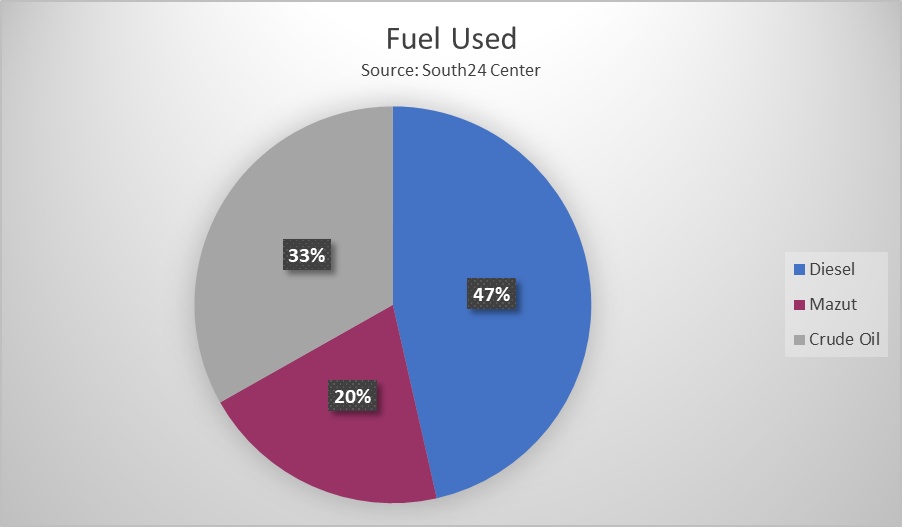
5. The Fuel Crisis and its Impact on Supply Stability
The suspension of the Saudi grant [2] for over one year has led to irregular fuel supplies and a sharp decline in electricity production. (In February 2024, Riyadh provided the second tranche - $250 million - of its promised $1 billion grant to Yemen). This has caused long power outages which sometimes extend to several days. Power stations rely on the continuous availability of fuel, which makes the sector vulnerable to political and economic crises which impact supplies.
6. Weak Management and the Spread of Corruption
Electricity corporations suffer from structural problems in management, which is reflected in poor competencies, the lack of training, absence of clear plans to measure performance and improve operational efficiency. Furthermore, the lack of oversight, accountability, and transparency in calculating costs have led to the spread of corruption in the sector, leading to further exacerbation of the crisis.
7. Growing Demand against Weak Generation Expansion
The large-scale displacement of people from areas affected by the conflict into Aden [3] has increased the population of the city, leading to a growing demand for power. However, the sector has not witnessed any major expansion projects to keep pace with this development. This has widened the gap between demand and supply, leading to a marked increase in power outage periods.
8. Impact of Power Outage on the Economy and Daily Life
People of Aden suffer from long electricity outages due to the inability of power plants to meet the growing demand and fuel shortage. The crisis reached its peak in February 2025 [4] after some stations stopped working for several consecutive days, leading to semi-paralysis in a number of vital sectors which directly impacted people’s daily lives.
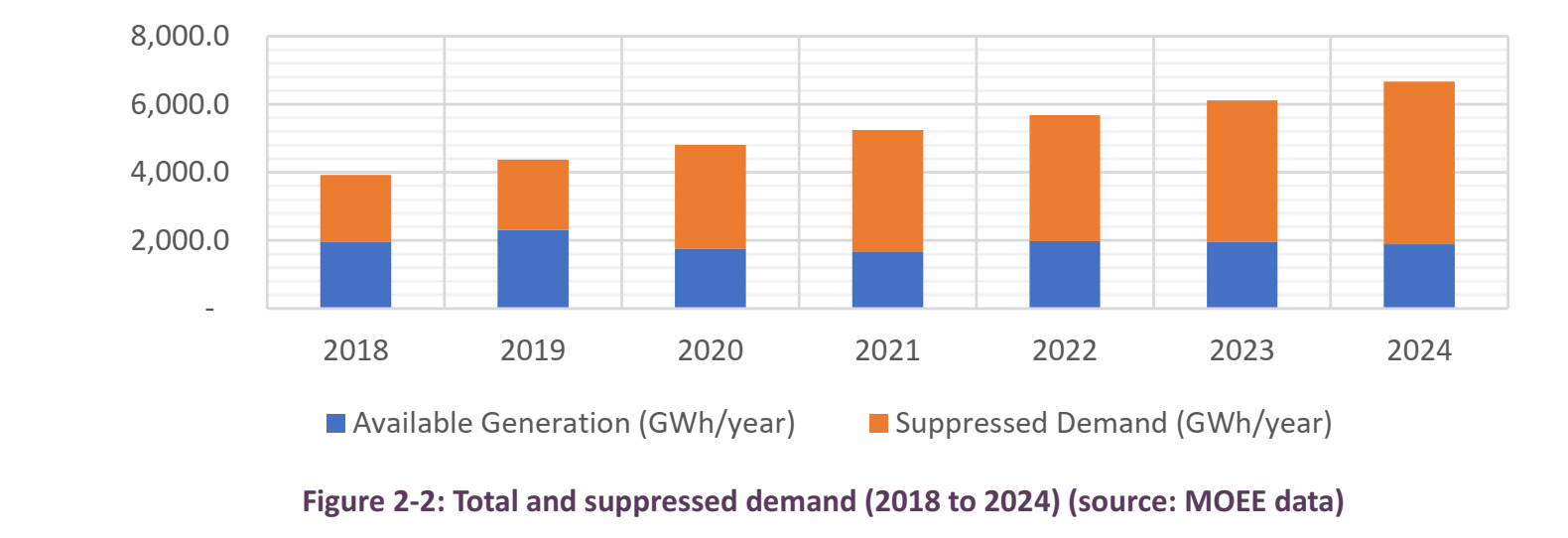
9. Financial Challenges and the Electricity Tariff Crisis
The electricity corporations suffer from a large financial deficit for several reasons, foremost of which are:
● Overdependence on costly diesel
● Declining efficiency of some stations like Haswah and PetroMasila
● Rise in percentage of electricity loss in the distribution grid
● Uneconomical tariff for sale of electricity which does not cover production costs
● Poor revenue collection from customers due to their impoverished livelihood and security conditions. Many electricity employees have been assaulted by citizens
Despite increasing the tariff for selling electricity to major customers (commercial, industrial, and governmental) to 400-500 SAR/KWh, it is still not enough to cover the fuel costs. Moreover, 65% of the electricity supply goes to the residential sector whose tariff hasn’t been upgraded, making the current average tariff cover only 10-15% of fuel costs, thus exacerbating the sector's financial crisis.
The following chart illustrates the percentage of each segment of consumers. The domestic sector constitutes 65% of total consumption and is sold at a very low tariff.
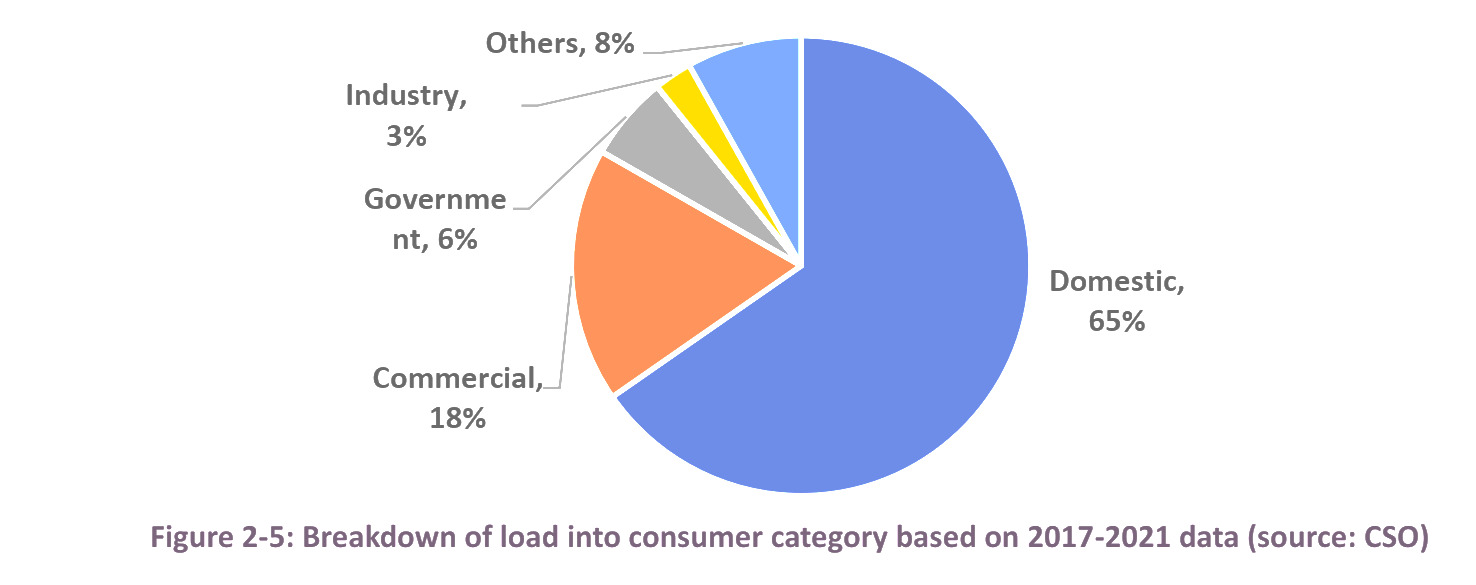
A Roadmap to Boost the Electricity Sector in Aden: Technical and Strategic Solutions
The electricity sector in Aden is facing serious challenges which require urgent and sustainable solutions to ensure the stability of power supply and improve the efficiency of the system. The proposed treatments are based on rehabilitation of the infrastructure, expanding the generation capacities, diversification of the energy sources whether traditional or renewable, enhancing financial and administrative performance, and activating the role of the private sector in investing in the energy sector like in the neighboring Arab states, even the rich ones such as Saudi Arabia, the UAE, and Kuwait.
1. Rehabilitation of Infrastructure: Restoring Generation Capacities
Many power stations and transmission lines in Aden have been largely damaged as a result of the armed conflict and technical neglect. This has led to relatively large portions of the generation capacity going out of service. In this regard, implementing urgent rehabilitation projects requires:
● Rehabilitation of the gas-powered Qatari station and resuming operations which will add about 60 megawatts to the system.
● Completion of maintenance of the Chinese turbine in the Haswah station and adding a boiler to turn it into the Combined Cycle system. This will increase its operational efficiency and add 60 megawatts to the system.
● Finishing rehabilitation of the Mansoura station (Warasla units) to improve the reliability of supplies and raise its available production capacity to 50 megawatts.
● Fixing the idle Warasla generator with a capacity of 5 megawatts in the Khur Maksar station and increasing its operational efficiency.
These projects can be completed in less than a year, provided that adequate funding is secured. This would enable the power system to recover approximately 125 megawatts from the aforementioned stations ahead of the summer of 2025/2026, significantly easing the city's electricity crisis.
2. Boosting Generation Capacity
Expanding generation capacity while striking a balance between conventional and renewable energy sources is a key pillar to ensuring sustainable electricity supply. This requires urgent implementation of the following measures:
● Switching the President station (PetroMasila) to the Combined Cycle system. This will reduce energy consumption by between 25% and 30%. This modification can be implemented within one year.
● Abolishing diesel-power energy contracts to reduce production costs and stop unjustified financial bleeding, and replacing them with contracts for mazut with a total capacity not less than 400 megawatts, based on transparent competitive bids. This can be implemented within 18 months of signing the contract.
● Increasing the production of the President station to 200 megawatts by ensuring provision of the required fuel, adding 110 megawatts to the generation capacity available.
● Implementation of the solar power plant expansion. This will contribute to supporting the grid with clean renewable energy and reducing the reliance on fossil fuel.
Estimates indicate that the demand for electricity in Aden and the neighboring governorates (Abyan, Lahij, and Al-Dhalea) will reach nearly 2000 megawatts by 2030 [5]. This will require injecting at least $3 billion over the next five years to develop the infrastructure of power plants as well as transmission and distribution grids.
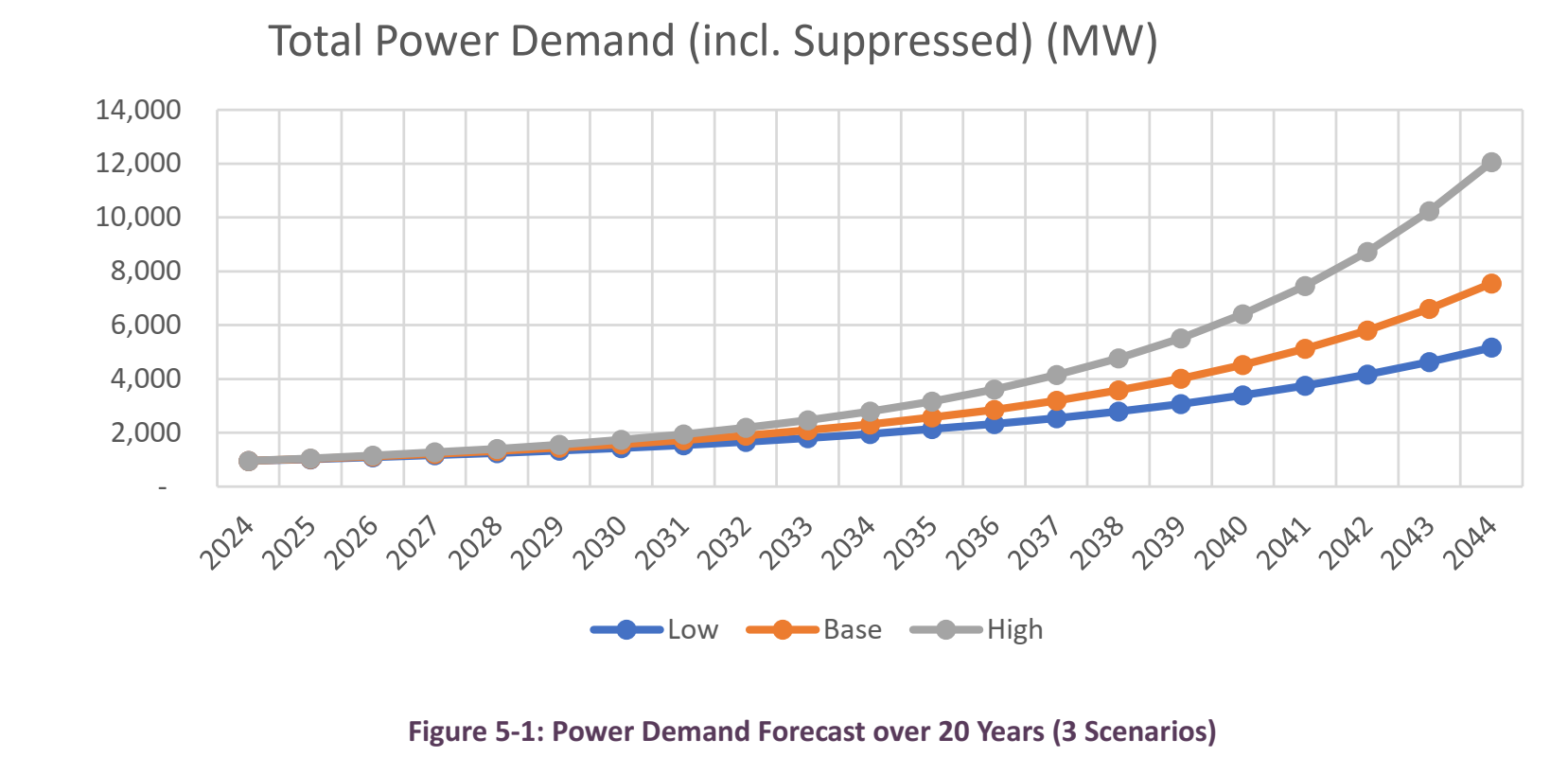
A diagram showing the expected total power demand from 2024 to 2044 with three scenarios (low, basic, high) [6]

The diagram shows the expected annual energy demand in the Aden grid from 2024 to 2044 with three scenarios (low, basic, high) [7]
3. Providing Fuel and Switching to Natural Gas
The lack of fuel is one of the most prominent challenges facing the electricity sector in Aden. This hinders operating the stations to their full capacities. To achieve supply stability, we need to focus on:
● Ensuring the import of the necessary fuel or producing it locally so that power stations operate efficiently.
● Planning to switch to natural gas from local sources at a price not exceeding $3 per million British thermal units (mmBTU) as the primary source for powering stations, like the Marib station, which will reduce operation costs and improve generation efficiency.
4. Improving Financial Performance: Reviewing the Tariff and Reducing Loss
The electricity sector is facing a severe financial crisis due to the soaring operational costs, the low collection rates, and the mounting losses. To improve the financial situation, the following steps should be taken:
● Reviewing the tariff structure and increasing it gradually over a period between 5-10 years to reach a level which reflects the actual cost of generating and transmitting power; reducing the non-technical losses; and increasing the collection rates.
5. Enhancing Participation of the Private Sector in Electricity
Given the financial challenges hindering the development of the sector, private sector involvement is an urgent necessity to finance and implement new energy projects. With expectations that the demand will reach 2000 megawatts over the coming five years, attracting private investments will contribute to accelerating the development of the electricity infrastructure.
Although the law regarding partnership between the public and private sectors was drafted in 2014, it hasn't so far been ratified or implemented to allow the private sector to participate in developing the electricity projects according to clear legal frameworks.
6. Administrative Reforms and Combating Corruption
The electricity sector in Aden needs essential administrative reforms to ensure operational competency and improve the level of services. This includes the following items:
● Appointing staff who are qualified in leadership positions to enhance management competency.
● Putting in place strict oversight mechanisms to combat financial and administrative corruption and ensuring transparency in project implementation.
● Making use of previous studies to reform the sector. They include for example the study prepared by the ’Arthur Andersen‘ company in 2000 which provided comprehensive recommendations to improve the electricity sector. However, they haven't been carried out so far.
Conclusion
Reforming the electricity sector in Yemen is considered a challenge which requires comprehensive response and tight coordination between the government, the private sector, and international community. This requires carrying out a clear and time-bound roadmap by benefiting from a study funded by the United Nations on developing the Aden electricity system, implemented by a consulting company. The study focuses on diversifying the energy sources between conventional and renewable ones and the gradual restructuring of electricity tariff to strike a balance between costs and sustainability. This is along with carrying out drastic reforms aimed at boosting the generation efficiency and improving the administrative and financial performance of the sector.
The study recommended carrying out new generation capacities of about 2000 megawatts by 2028, 50% of which would be gas stations powered by crude oil, while 50% would be renewable energy stations, including solar and wind. In my personal estimate, this will require no less than $3 billion funding at a rate of $600 million annually to implement these additions in the electricity sector, which will require contributions from the local and foreign private sector in implementing the electricity projects.
The implementation of this plan will constitute a turning point in the stability of the electricity sector in Aden and the nearby governorates through enhancing the operational competency, upgrading infrastructure, and improving management of the electricity grid. Furthermore, enhancing the partnership between the government and the private sector along with the donors can contribute to laying a strong foundation for a more sustainable and credible electricity system capable of meeting the growing power demand and supporting the economic developments in the city.